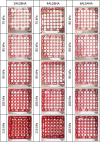Modeling a Dynamic Printability Window on Polysaccharide Blend Inks for Extrusion Bioprinting
- PMID: 36848685
- PMCID: PMC10015426
- DOI: 10.1021/acsbiomaterials.2c01143
Modeling a Dynamic Printability Window on Polysaccharide Blend Inks for Extrusion Bioprinting
Abstract
Extrusion-based bioprinting is one of the most widespread technologies due to its affordability, wide range of processable materials, and ease of use. However, the formulation of new inks for this technique is based on time-consuming trial-and-error processes to establish the optimal ink composition and printing parameters. Here, a dynamic printability window was modeled for the assessment of the printability of polysaccharide blend inks of alginate and hyaluronic acid with the intent to build a versatile predictive tool to speed up the testing procedures. The model considers both the rheological properties of the blends (viscosity, shear thinning behavior, and viscoelasticity) and their printability (in terms of extrudability and the ability of forming a well-defined filament and detailed geometries). By imposing some conditions on the model equations, it was possible to define empirical bands in which the printability is ensured. The predictive capability of the built model was successfully verified on an untested blend of alginate and hyaluronic acid chosen to simultaneously optimize the printability index and minimize the size of the deposited filament.
Keywords: extrusion bioprinting; hyaluronic acid; printability; sodium alginate.
Conflict of interest statement
The authors declare no competing financial interest.
Figures









References
-
- Chen D. X. B.Extrusion Bioprinting of Scaffolds. In Extrusion Bioprinting of Scaffolds for Tissue Engineering Applications; Chen D. X. B., Ed.; Springer International Publishing: Cham, 2019; pp. 117–145, 10.1007/978-3-030-03460-3_6. - DOI
-
- Ozbolat I. T.; Moncal K. K.; Gudapati H. Evaluation of Bioprinter Technologies. Addit. Manuf. 2017, 13, 179–200. 10.1016/j.addma.2016.10.003. - DOI
-
- Ramesh S.; Harrysson O. L. A.; Rao P. K.; Tamayol A.; Cormier D. R.; Zhang Y.; Rivero I. V. Extrusion Bioprinting: Recent Progress, Challenges, and Future Opportunities. Bioprinting 2021, 21, e0011610.1016/j.bprint.2020.e00116. - DOI
Publication types
MeSH terms
Substances
LinkOut - more resources
Full Text Sources

